PP, commonly known as polypropylene, is also known as “100% glue” because of its good fracture resistance. PP is a translucent, semi-crystalline thermoplastic with high strength, good insulation, low water absorption, high heat-setting temperature, low density, and high crystallinity. Modified fillers usually include glass fibers, mineral fillers, thermoplastic rubber, etc.

About Injection Molding Process of Polypropylene
At present, according to the different reaction medium and reactor configuration, there are three main types of polypropylene production processes: slurry process, bulk process and gas phase process.
Slurry Method
Dissolve propylene in inert hydrocarbon diluents (such as butane, pentane, hexane, heptane or nonane) for polymerization. Typical processes include Italy’s Montedison process, American Hercules process, Japan’s Mitsui Chemicals process , American Amoco process, Japan’s Mitsui petrochemical process and Sowell process, etc.;
Bulk Method
It is the polymerization reaction of liquid propylene. This process does not add any other solvent in the reaction system, and the catalyst is directly dispersed in the liquid phase propylene to carry out the liquid phase bulk polymerization of propylene. Typical processes include the Spheripol process of Basel Corporation. , Hypol process of Japan’s Mitsui Chemicals, Borstar process of Borealis, etc.
Gas-phase Method
Direct gas-phase polymerization of propylene produces solid-phase polymer products. Typical processes include DOW’s Unipol process, CB&I (former ABB)’s Novolen process, INEOS (BP)’s Innovene process, Lyondell-Basell’s Spherizone process, etc. Among all the patented technologies of propylene polymerization, there are four processes, Spheripol, Unipol, Innovene, and Novnlen, which are widely used at present.
The fluidity of PP for different purposes is quite different, and the flow rate of PP generally used is between ABS and PC.
1. Treatment of plastics. Pure PP is translucent ivory white and can be dyed in various colors. The dyeing of PP can only use color masterbatch on the general injection molding machine. On the Ramada machine, there is a plasticizing element that strengthens the mixing effect, and it can also be dyed with toner. Products for outdoor use are generally filled with UV stabilizers and carbon black. The proportion of recycled materials should not exceed 15%, otherwise it will cause strength reduction and decomposition and discoloration. PP injection molding generally does not require special drying before processing.
2. There are no special requirements for the selection of injection molding machines. Because PP has high crystallinity. Computer injection molding machines with high injection pressure and multi-stage control are required. The clamping force is generally determined by 3800t/m2, and the injection volume is 20%-85%.
3. The mold and gate design mold temperature is 50-90 °C, and high mold temperature is used for higher size requirements. The core temperature is more than 5°C lower than the cavity temperature, the diameter of the runner is 4-7mm, the length of the needle gate is 1-1.5mm, and the diameter can be as small as 0.7mm. The shorter the length of the edge gate, the better, about 0.7mm, the depth is half of the wall thickness, the width is twice the wall thickness, and gradually increases with the length of the melt flow in the mold cavity. The mold must have good venting. The vent hole is 0.025mm-0.038mm deep and 1.5mm thick. To avoid shrinkage marks, it is necessary to use large and round nozzles and circular runners, and the thickness of the reinforcing ribs should be small ( e.g. 50-60% of the wall thickness). For products made of homopolymeric PP, the thickness should not exceed 3mm, otherwise there will be bubbles (thick-walled products can only use copolymerized PP).
4. Melting temperature The melting point of PP is 160-175 °C, and the decomposition temperature is 350 °C, but the temperature setting cannot exceed 275 °C during injection processing. The temperature z of the melting section is preferably 240°C.
5. In order to reduce internal stress and deformation, high-speed injection should be selected for injection speed, but some grades of PP and molds are not suitable (bubbles and gas lines appear in the mantle). If the patterned surface appears light and dark streaks diffused by the gate, low-speed injection and high mold temperature should be used.
6. The back pressure of the melt adhesive can be 5bar, and the back pressure of the toner material can be adjusted appropriately.
7. High injection pressure (1500-1800bar) and holding pressure (about 80% of the injection pressure) are used for injection and pressure holding. Switch to holding pressure at about 95% of the full stroke, and use a longer holding time.
8. Post-treatment of products In order to prevent shrinkage and deformation caused by post-crystallization, products generally need to be soaked in hot water.
PP board generally has rice gray, primary color, porcelain white and so on. PP board conventional standard board; there are large board 1.5M*3M, small board 1.22M*2.44M, thickness from 3mm, PP board corrosion resistance, acid and alkali resistance, high temperature resistance of 80 degrees, easy to weld. PP board is widely used in waste gas treatment systems in chemical, machinery, food, electronics, medicine and other fields, such as acid and alkali resistance equipment, environmental protection equipment, waste water and waste gas treatment equipment.